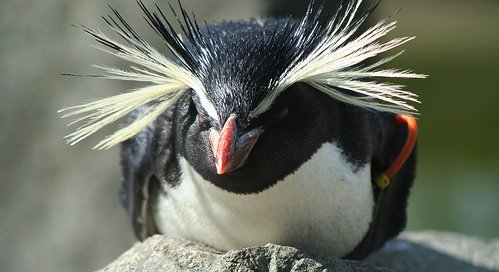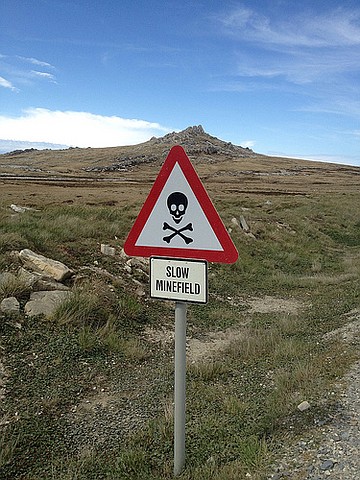 Facebook
Facebook
 X
X
 Instagram
Instagram
 TikTok
TikTok
 Youtube
Youtube

Keith the Kelper grapples with the wires, yanking some down, twisting them, forwards, backwards and then finally wrapping them tightly around the post.
“It’s those cows that do this, they chew the signs I suppose and they like the look of that tussock grass beyond the barbed wire.”
Keith Heathman’s attentions are directed solely at the mangled section of barbed wire fencing. He does not appear to notice the rays of sunlight glancing off the crests of the nearby waves, the mass of gulls roosting on the shore nor the 90 strong pairs of Gentoo penguins congregated on the dramatically rugged edges of Bluff Cove that frame and would exceed any wildlife enthusiast’s ideal vista.
I am no twitcher, but this is incredible.
To my left, Keith goes about his business with the fencing as if there were nothing amiss. Perhaps as a born-and-bred Kelper – a native of the Falkland Islands – being surrounded by penguins does not come as a surprise. Maybe he keeps his back turned to try and block out some of the stench.
This is far as I can get. Hindered not by the tear-inducing smell, but the fencing. The wire here could be in place to keep the flora and fauna protected, but in fact it’s there for the benefit of the number-one predator: humans.

To step, even carefully, beyond the now studiously repaired boundary could lead to an unpleasant and untimely demise. This wiring shields the wildlife from us and we in turn from the mines planted here some 25 years ago, which litter the islands as a macabre tourist attraction or effective wildlife perimeter announcing the legacy of the 1982 Falklands conflict.
“I was taking some tourists from a luxury cruise here to Bluff Cove to see the penguins a few years ago and I point out that all these surrounding fields are mined. And the tourist says to me, 'Mined for what?' Sometimes I don’t know what to say!”
One imagines that Keith says nothing. Tourism is booming here, and competition is high between Islanders. There is an emphasis on drawing the cruise ship visitors back to the Islands as land-based tourists, willing to spend more money and visit areas further afield.
Job complete, Keith Heathman, contract sheep shearer and erstwhile tour guide, lets me know that there are something akin to 30,000 active mines still left on the islands and that he is responsible for maintaining 57 of the sites. We head on to Beach Cove, where I am barely able to hold the camera steady due to the 40-knot winds, snow, sleet and then rain flung at me.
The one constant is the merciless wind. All other weather patterns cease, yet the wind whips up icy grains of sand, freezing sea mists and threatens to impede my viewing pleasure of the pair of King Penguins and chick before me.
Snapping rapidly to protect my fingers from frostbite, I am breathless with excitement at these majestic creatures, and their resilience to the elements reminds me of a saying a Swedish friend of mine would utter in times such as this: “There is no such thing as bad weather, only the wrong clothes.”
The King Penguins are ideally suited.
One wonders if the penguins that abound here are grateful to the minefield sanctuaries bequeathed to them. It is among these plastic parcels of destruction that King, Gentoo and Rockhopper penguins come to nest, relatively sheltered from the interference of man.
The levels of interference are relative. Even now in the off-season one can see the scars from last year's tours in the form of 4x4 carved rivets through the diddle-dee, tussock grass and heathland. Such is the difficulty of managing the equilibrium between sustainable tourism, growth and a fragile environment.
According to Grant Munro, CEO of Falklands Conservation, this balance is hard to strike, but is being managed admirably.
“We don't want want to be obstructive to the diversification of the economy. Progress here needs to be in a measured fashion. Steady growth and realization. The main sites need to be well-managed and developed, almost sacrificed for the sake of the others.”
The next threats of rampant over-exploitation could well surface in the forms of commercial fishing and unregulated tourism. Rockhopper penguins are reflecting the worldwide decline in their species with falling numbers here, and 19 of the 21 species of albatross are endangered. It remains to be seen how tourism and the environment, so often uneasy bedfellows, will shape up in this startlingly rich and fragile ecosystem.
One hopes that the Falklands find the ideal way forward.


Keith the Kelper grapples with the wires, yanking some down, twisting them, forwards, backwards and then finally wrapping them tightly around the post.
“It’s those cows that do this, they chew the signs I suppose and they like the look of that tussock grass beyond the barbed wire.”
Keith Heathman’s attentions are directed solely at the mangled section of barbed wire fencing. He does not appear to notice the rays of sunlight glancing off the crests of the nearby waves, the mass of gulls roosting on the shore nor the 90 strong pairs of Gentoo penguins congregated on the dramatically rugged edges of Bluff Cove that frame and would exceed any wildlife enthusiast’s ideal vista.
I am no twitcher, but this is incredible.
To my left, Keith goes about his business with the fencing as if there were nothing amiss. Perhaps as a born-and-bred Kelper – a native of the Falkland Islands – being surrounded by penguins does not come as a surprise. Maybe he keeps his back turned to try and block out some of the stench.
This is far as I can get. Hindered not by the tear-inducing smell, but the fencing. The wire here could be in place to keep the flora and fauna protected, but in fact it’s there for the benefit of the number-one predator: humans.

To step, even carefully, beyond the now studiously repaired boundary could lead to an unpleasant and untimely demise. This wiring shields the wildlife from us and we in turn from the mines planted here some 25 years ago, which litter the islands as a macabre tourist attraction or effective wildlife perimeter announcing the legacy of the 1982 Falklands conflict.
“I was taking some tourists from a luxury cruise here to Bluff Cove to see the penguins a few years ago and I point out that all these surrounding fields are mined. And the tourist says to me, 'Mined for what?' Sometimes I don’t know what to say!”
One imagines that Keith says nothing. Tourism is booming here, and competition is high between Islanders. There is an emphasis on drawing the cruise ship visitors back to the Islands as land-based tourists, willing to spend more money and visit areas further afield.
Job complete, Keith Heathman, contract sheep shearer and erstwhile tour guide, lets me know that there are something akin to 30,000 active mines still left on the islands and that he is responsible for maintaining 57 of the sites. We head on to Beach Cove, where I am barely able to hold the camera steady due to the 40-knot winds, snow, sleet and then rain flung at me.
The one constant is the merciless wind. All other weather patterns cease, yet the wind whips up icy grains of sand, freezing sea mists and threatens to impede my viewing pleasure of the pair of King Penguins and chick before me.
Snapping rapidly to protect my fingers from frostbite, I am breathless with excitement at these majestic creatures, and their resilience to the elements reminds me of a saying a Swedish friend of mine would utter in times such as this: “There is no such thing as bad weather, only the wrong clothes.”
The King Penguins are ideally suited.
One wonders if the penguins that abound here are grateful to the minefield sanctuaries bequeathed to them. It is among these plastic parcels of destruction that King, Gentoo and Rockhopper penguins come to nest, relatively sheltered from the interference of man.
The levels of interference are relative. Even now in the off-season one can see the scars from last year's tours in the form of 4x4 carved rivets through the diddle-dee, tussock grass and heathland. Such is the difficulty of managing the equilibrium between sustainable tourism, growth and a fragile environment.
According to Grant Munro, CEO of Falklands Conservation, this balance is hard to strike, but is being managed admirably.
“We don't want want to be obstructive to the diversification of the economy. Progress here needs to be in a measured fashion. Steady growth and realization. The main sites need to be well-managed and developed, almost sacrificed for the sake of the others.”
The next threats of rampant over-exploitation could well surface in the forms of commercial fishing and unregulated tourism. Rockhopper penguins are reflecting the worldwide decline in their species with falling numbers here, and 19 of the 21 species of albatross are endangered. It remains to be seen how tourism and the environment, so often uneasy bedfellows, will shape up in this startlingly rich and fragile ecosystem.
One hopes that the Falklands find the ideal way forward.
Comments